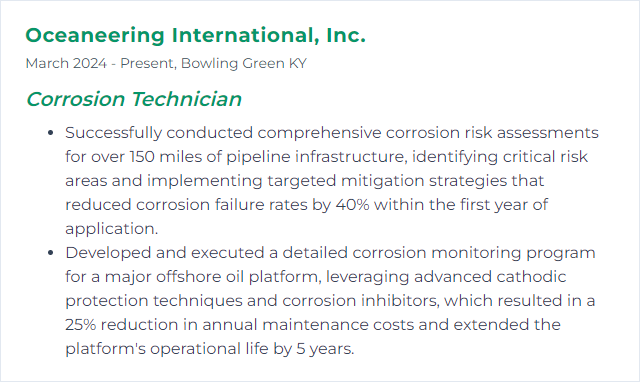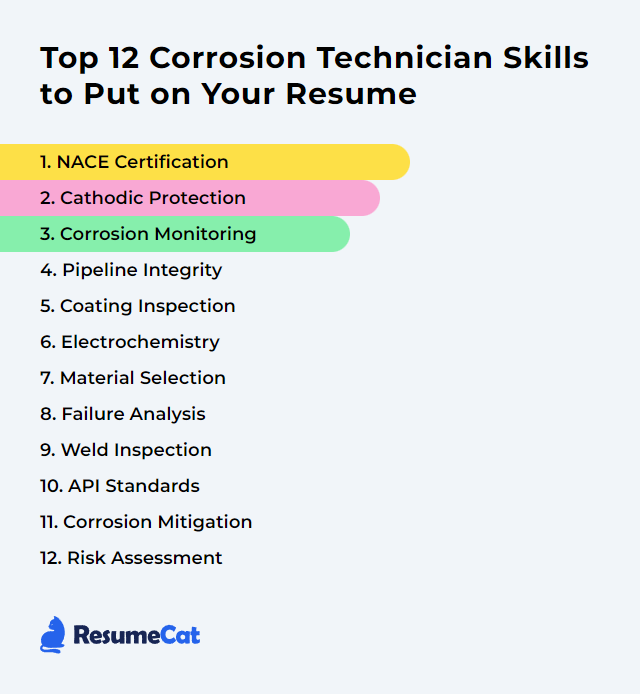Top 12 Corrosion Technician Skills to Put on Your Resume
In the highly specialized field of corrosion control, showcasing a sharp, well-rounded skill set on your resume can lift your chances with hiring teams fast. The following guide highlights twelve core skills corrosion technicians should emphasize to prove capability, judgment, and readiness to protect assets from the relentless creep of corrosion.
Corrosion Technician Skills
- NACE Certification
- Cathodic Protection
- Corrosion Monitoring
- Pipeline Integrity
- Coating Inspection
- Electrochemistry
- Material Selection
- Failure Analysis
- Weld Inspection
- API Standards
- Corrosion Mitigation
- Risk Assessment
1. NACE Certification
NACE certification, relevant to Corrosion Technicians and now administered by AMPP (the Association for Materials Protection and Performance), recognizes professional expertise in preventing, inspecting, and mitigating corrosion across structures and materials.
Why It's Important
NACE Certification signals proven competence in corrosion control, adherence to industry standards, and commitment to safe, effective practices—boosting credibility and expanding job opportunities.
How to Improve NACE Certification Skills
Strengthening your NACE/AMPP credentials blends experience with continuous learning. A quick roadmap:
Gain Practical Experience: Get hands-on. Field work hardens theory into judgment. Projects involving CP, coatings, and monitoring matter.
Continuing Education: Take advanced AMPP courses and workshops to stay current with evolving methods, materials, and standards.
Networking: Join professional communities and technical forums. Conversations with practitioners surface tips you won’t find in manuals.
Progress to Higher Levels: As experience grows, pursue advanced certifications and specialty tracks aligned to your sector.
Attend Seminars and Conferences: Keep in touch with new research, tools, and case studies. Present if you can—teaching sharpens mastery.
Read and Contribute: Follow journals like CORROSION and industry magazines. Publish brief case notes or lessons learned.
Ethics and Professionalism: Uphold AMPP’s code. Reputation compounds over time.
These steps build both technical capability and professional standing—credentials with teeth.
How to Display NACE Certification Skills on Your Resume
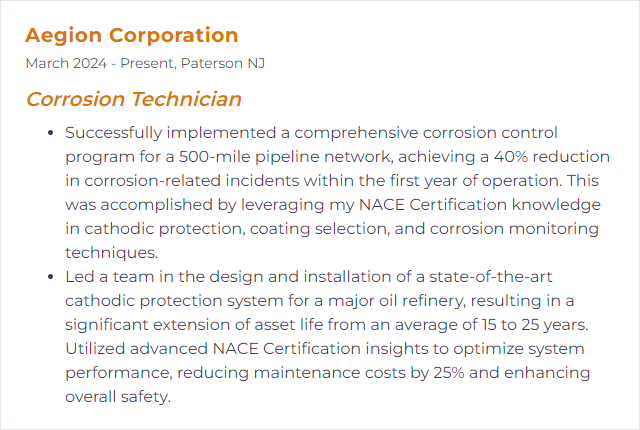
2. Cathodic Protection
Cathodic protection (CP) prevents metal corrosion by shifting the protected surface to a cathodic state, either by attaching sacrificial anodes or by applying an impressed current.
Why It's Important
CP preserves buried, submerged, and reinforced assets, slashing failure risk and lifecycle costs while helping maintain structural integrity.
How to Improve Cathodic Protection Skills
Better CP, fewer surprises. Focus on design rigor and vigilant care:
Assessment and Monitoring: Measure structure-to-electrolyte potentials, current distribution, and continuity routinely. Verify criteria, adjust when conditions change.
Anode Selection and Placement: Match environment and load to anode type (galvanic vs. impressed current), then place for uniform current spread.
Electrical Continuity: Confirm bonds across isolated components so protection isn’t patchy or blind.
Regular Inspections and Maintenance: Check anodes, rectifiers, reference electrodes, and wiring. Replace spent anodes, recalibrate power, validate readings seasonally.
Modeling and Design Tools: Use CP design software and mapping data to predict potential distributions and optimize layouts.
Training and Standards: Follow AMPP guidance and relevant standards. Formal training raises the floor for quality.
How to Display Cathodic Protection Skills on Your Resume

3. Corrosion Monitoring
Corrosion monitoring tracks degradation rates and conditions over time using probes, inspections, and analytics to reveal how and where materials are losing wall, long before failure.
Why It's Important
Early detection prevents leaks, downtime, and hazards. It informs targeted maintenance and smarter budgets.
How to Improve Corrosion Monitoring Skills
Make monitoring nimble and data rich:
Advanced Sensors: Deploy smart probes for ER, LPR, and coupon programs; log temperature, pH, and chemistry alongside.
Non-Destructive Testing: Use ultrasonic thickness, radiography, eddy current, and guided wave methods to see beyond the surface.
Digital Platforms: Centralize data streams; trend, alert, and visualize in one place.
Visual Inspections: Don’t neglect the basics. Frequent walkdowns and drone-assisted checks catch context and anomalies.
Corrosion Inhibitors: Where appropriate, add or optimize inhibitors matched to your environment and metallurgy.
Analytics and Modeling: Predict rates and hotspots from historical and real-time inputs; prioritize accordingly.
Training: Refresh techniques and calibrations. Methods evolve; your approach should too.
Collaborate: Work with process, inspection, and materials teams. Corrosion is cross-disciplinary by nature.
How to Display Corrosion Monitoring Skills on Your Resume

4. Pipeline Integrity
Pipeline integrity blends design, monitoring, and maintenance to ensure safe, reliable operation—limiting threats from corrosion, defects, and external forces.
Why It's Important
Integrity programs prevent leaks and ruptures, shield the environment, and keep supply moving. A corrosion technician’s vigilance is central to that promise.
How to Improve Pipeline Integrity Skills
Hone the fundamentals—then connect the dots:
Routine Inspections and ILI: Use in-line inspection tools and verify effectiveness of cathodic protection. Track degradation modes over time.
Robust CP: Design, implement, and tune CP to control external corrosion, validating criteria at seasonally variable sites.
Coatings and Linings: Specify, inspect, and repair barriers that block corrosive agents. Surface prep quality is non-negotiable.
Environment Controls: Address soil corrosivity, moisture, stray current, and temperature where feasible.
Data-Driven Risk: Analyze inspection, monitoring, and operating data. Rank risk and prioritize interventions.
Training and Standards: Keep current with AMPP and industry guidance; refresh certifications as tools and rules advance.
How to Display Pipeline Integrity Skills on Your Resume
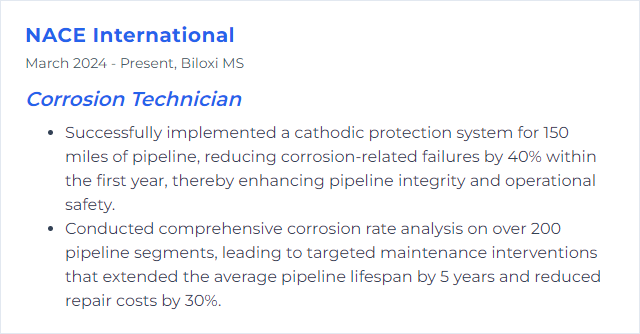
5. Coating Inspection
Coating inspection evaluates the quality and integrity of protective systems on metal surfaces—surface prep, film thickness, adhesion, cure, holidays—to keep corrosion at bay.
Why It's Important
Good coatings fail when application or inspection is poor. Careful verification saves rework, prevents underfilm corrosion, and extends service life.
How to Improve Coating Inspection Skills
Precision beats guesswork:
Education: Stay current on technologies, chemistries, and application methods through AMPP and legacy SSPC/NACE resources.
Advanced Tools: Master digital DFT gauges, adhesion testers, holiday detectors, hygrometers, and surface profile gages. Calibrate regularly.
Follow Standards: Apply relevant AMPP and legacy NACE/SSPC standards (e.g., surface cleanliness and thickness measurement procedures).
Practice: Hands-on training and mock-ups sharpen judgment on borderline conditions and acceptance criteria.
Compliance and Safety: Align with applicable environmental and worker-safety requirements throughout prep and application.
Peer Networks: Trade notes with coating specialists; field insights reduce avoidable errors.
How to Display Coating Inspection Skills on Your Resume
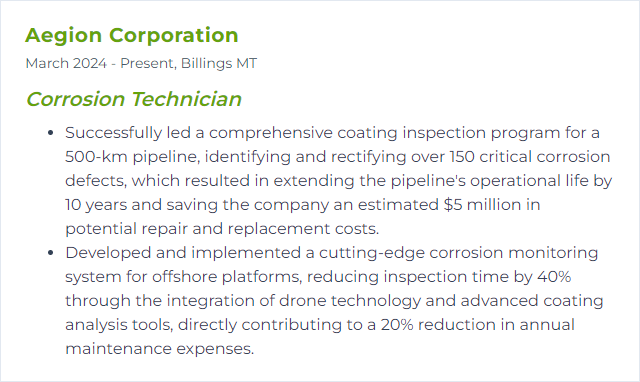
6. Electrochemistry
Electrochemistry studies reactions at electrode–electrolyte interfaces—charge transfer, potential, kinetics. Corrosion is electrochemical at its core, so understanding these processes is the technician’s lever for control.
Why It's Important
It underpins corrosion prediction and prevention, guiding choices for CP, inhibitors, material pairing, and monitoring techniques.
How to Improve Electrochemistry Skills
Blend theory with field reality:
Solidify Fundamentals: Refresh thermodynamics, kinetics, Pourbaix concepts, galvanic series, and diffusion limits through reputable technical societies.
Practice in Context: Apply LPR, EIS, and coupon programs; link lab results to field performance.
Stay Updated: Follow CORROSION and related journals; attend workshops that bridge research and applied practice.
Network: Compare methods and findings with peers; diverse environments reveal edge cases.
Modeling and Software: Use simulation tools to explore mechanisms and validate mitigations before deployment.
Safety and Stewardship: Handle chemicals and energized systems by the book; document hazards and controls.
How to Display Electrochemistry Skills on Your Resume
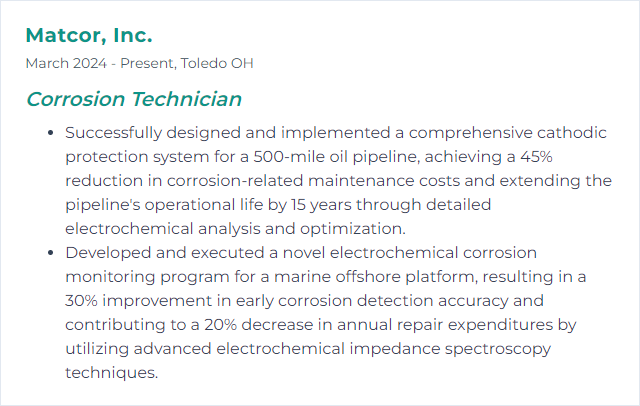
7. Material Selection
Material selection matches service conditions to materials with the right corrosion resistance, mechanical properties, fabricability, and cost profile so systems last as intended.
Why It's Important
The right alloy or polymer reduces failures and downtime, often more economically than heavy mitigation after the fact.
How to Improve Material Selection Skills
Context is king. Weigh environment, design, and economics together:
Define the Environment: Chemistry, temperature, pressure, flow regime, microbes, and cyclic loading all matter.
Know Material Properties: Use trusted databases and handbooks from ASM International and others to compare options.
Corrosion Resistance: Align materials to specific mechanisms expected—pitting, SCC, MIC, erosion-corrosion.
Protective Coatings: Where needed, pair materials with coatings or surface treatments for added margin.
Design Integration: Respect geometry, joints, weldability, and construction constraints; avoid galvanic traps.
Cost Over Lifecycle: Balance initial spend versus failure probability and maintenance burden—total cost of ownership, not sticker price.
Standards and Codes: Confirm compliance with ASTM, ASME, API, and project specifications.
Consult and Collaborate: Work with materials engineers and fabricators; practical feedback trims risk.
How to Display Material Selection Skills on Your Resume

8. Failure Analysis
Failure analysis dissects why a component degraded or broke—mechanism, root cause, contributing factors—then maps actions to prevent a repeat.
Why It's Important
It closes the loop between symptom and solution, turning incidents into durable improvements in materials, design, or operation.
How to Improve Failure Analysis Skills
Think like a detective; document like a scientist:
Understand Corrosion Mechanisms: Review types and triggers of corrosion relevant to your assets.
Comprehensive Data Capture: Collect service history, environment, process upsets, and maintenance records.
Visual Examination: Map damage patterns, morphology, and fracture appearance before disturbing evidence.
Non-Destructive Testing: Use UT, RT, MT, PT to reveal subsurface flaws without further harm.
Laboratory Analysis: Apply SEM/EDS, metallography, hardness testing, and chemistry to pinpoint mechanisms.
Root Cause Analysis: Use structured RCA to separate proximate causes from the true root.
Report and Recommend: Provide clear findings, evidence, and actionable prevention steps.
Keep Learning: Update methods via professional courses and technical literature.
How to Display Failure Analysis Skills on Your Resume

9. Weld Inspection
Weld inspection verifies welds meet acceptance criteria and won’t become corrosion incubators or weak links under load or exposure.
Why It's Important
Defects and poor surface condition accelerate corrosion and cracking. Early detection and correction protect integrity and safety.
How to Improve Weld Inspection Skills
Sharpen your eye and your toolkit:
Visual Inspection Mastery: Read profiles, colors, heat tint, undercut, and spatter. Document thoroughly.
Non-Destructive Testing: Apply UT, MT, PT, and RT as needed for subsurface and surface-breaking flaws.
Corrosion Mapping: Track thickness loss near welds and HAZ over time using precise UT methods.
Codes and Standards: Stay aligned with applicable AWS, ASME, API, and AMPP guidance.
Continuous Learning: Workshops, mentoring, and certification refreshers keep technique sharp.
Corrosion Controls: Specify compatible fillers, control post-weld cleanup and passivation, apply protective coatings, and validate CP performance at welds.
How to Display Weld Inspection Skills on Your Resume

10. API Standards
API standards provide frameworks for design, inspection, corrosion control, and fitness-for-service in oil and gas assets.
Why It's Important
They promote consistent, proven practices that protect people, the environment, and operations—while helping maintain regulatory compliance.
How to Improve API Standards Skills
Make standards living tools, not shelf décor:
Keep Current: Track updates and interpretations; enroll in relevant training.
Contribute: Participate in committees or user groups; field experience shapes better standards.
Apply Best Practices: Embed guidance from documents like API 571, 580, and 581 into procedures and RBI programs.
Document Case Studies: Share lessons learned to refine internal practices and influence revisions.
Collaborate Broadly: Compare approaches across operators and service providers; convergence improves outcomes.
Adopt New Tech: Integrate advanced NDT and monitoring tools; validate against API methods.
Safety and Environmental Alignment: Ensure your procedures dovetail with safety management systems and environmental requirements.
How to Display API Standards Skills on Your Resume
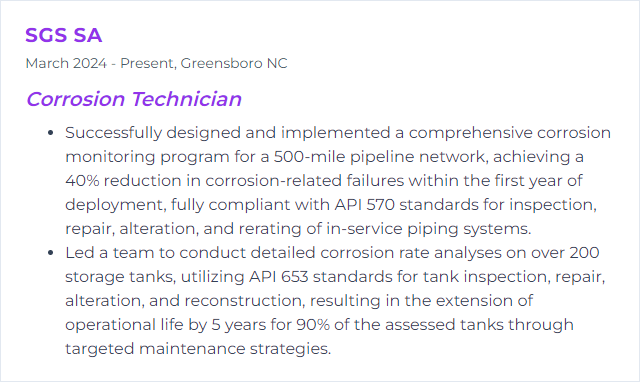
11. Corrosion Mitigation
Corrosion mitigation gathers the tactics—materials, design, coatings, CP, inhibitors, environment control—that slow or stop damage before it snowballs.
Why It's Important
It extends asset life, prevents leaks and failures, improves reliability, and shrinks total cost of ownership.
How to Improve Corrosion Mitigation Skills
Mix defense-in-depth with smart monitoring:
Material Selection: Favor alloys or polymers matched to the specific environment and damage mechanisms.
Protective Coatings: Specify coating systems with validated surface prep and QA, tailored to exposure.
Cathodic Protection: Apply galvanic or impressed current systems where they make sense and maintain them.
Corrosion Inhibitors: Dose and verify performance; adjust for process swings.
Monitoring and Maintenance: Use ER/LPR, UT, and inspections to catch drift early and recalibrate defenses.
Environment Control: Reduce moisture, contaminants, and differential aeration whenever feasible.
How to Display Corrosion Mitigation Skills on Your Resume
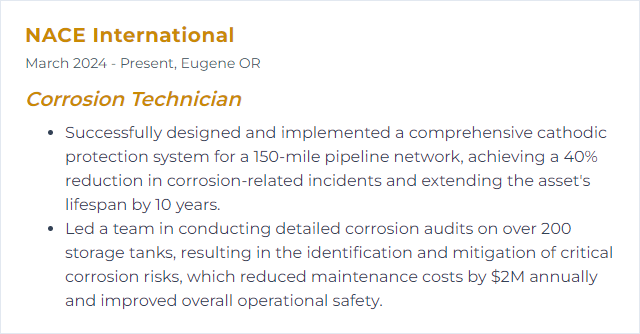
12. Risk Assessment
Risk assessment evaluates corrosion threats, their likelihood and consequences, and guides inspection and mitigation to where they matter most.
Why It's Important
It prioritizes limited resources, cuts unplanned downtime, and supports safer, more reliable operations.
How to Improve Risk Assessment Skills
Sharper inputs, clearer decisions:
Update the Knowledge Base: Understand materials, environments, and damage mechanisms relevant to your assets.
Use Modern Tools: Apply corrosion mapping, RBI software, and predictive analytics to focus attention.
Implement RBI: Follow frameworks such as API 580/581 to structure decisions and inspection intervals.
Keep Learning: Take professional courses; review notable failures and their lessons.
Field Time: Nothing substitutes for on-site exposure; patterns and edge cases become obvious up close.
Collaborate: Align with inspection, process, and operations teams to balance risk, cost, and practicality.
How to Display Risk Assessment Skills on Your Resume
